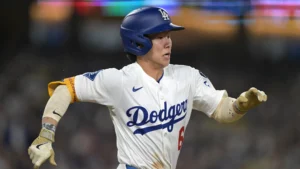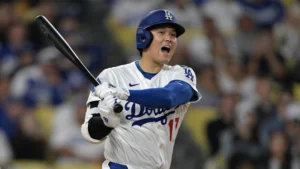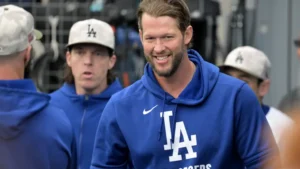
Baltimore Orioles Pitching Staff Struggling Bad in 2025: What Went Wrong and What Comes Next
Just two years removed from a 101-win season that sparked dreams of a new dynasty in Baltimore, the Orioles’ 2025 campaign has become a cautionary tale. Once viewed as one of the brightest young teams in all of Major League Baseball, the Orioles have been derailed by one glaring and devastating flaw: their pitching staff.
Despite entering the season with expectations of competing in the AL East, the Orioles find themselves hovering near the basement of the standings. While injuries, regression, and underperformance have affected the entire roster, no unit has struggled more—or cost the team more games—than the pitching staff.
From injuries to ace starters, to a bullpen in total disarray, the once-formidable Orioles pitching corps is now one of the weakest in the American League. And unless Baltimore can make major changes—both in philosophy and personnel—their chances of salvaging the season are fading fast.
Preseason Expectations: Hope Was High
Coming into the 2025 season, the Orioles believed they had the right balance of youth and experience to contend. After acquiring Corbin Burnes in a bold 2024 trade, re-signing Kyle Bradish, and watching Grayson Rodriguez blossom into a front-line starter, Baltimore was supposed to have a rotation capable of matching up with anyone in the league.
The bullpen, meanwhile, was anchored by All-Star closer Félix Bautista, setup man Yennier Cano, and swingmen like DL Hall and Keegan Akin.
On paper, it looked like one of the more complete staffs in the AL.
But paper doesn’t win baseball games—healthy arms and execution do.
Injuries Decimate the Rotation
The first domino fell in March when it was confirmed that Félix Bautista would miss the entire 2025 season recovering from Tommy John surgery. That was a known loss, but it stung even more when Kyle Bradish suffered a shoulder injury just weeks into the regular season.
Grayson Rodriguez has tried to hold the rotation together, but he’s been inconsistent. His ERA, which hovered around 3.50 in 2024, has ballooned to 4.87 in 2025. His strikeouts are down, and his command has become a growing concern.
Veteran Corbin Burnes, expected to be the staff’s ace, has battled back tightness and seen his fastball velocity dip. His ERA sits north of 4.30—unacceptable for a pitcher of his pedigree and salary.
Other injuries have compounded the problem:
- John Means is on the IL with an elbow strain.
- Dean Kremer has dealt with forearm tightness and hasn’t looked like the dependable No. 4 starter of old.
- Tyler Wells, once a promising long-reliever and spot starter, is struggling to return from elbow inflammation.
The result? The Orioles have used 11 different starting pitchers through the first six weeks of the season—most in the AL—and only two have a sub-5.00 ERA.
Bullpen Collapse: Once a Weapon, Now a Liability
In 2023 and 2024, Baltimore’s bullpen was its not-so-secret weapon. Félix Bautista was virtually unhittable, Yennier Cano was elite, and late-inning leads felt safe. Fast forward to 2025, and it’s a complete reversal.
Without Bautista, Cano has been forced into the closer’s role. But overuse and poor location have led to a disastrous start. Through 25 appearances, Cano holds a 5.64 ERA, with three blown saves and two losses in extra innings.
Lefty specialist Cionel Pérez has lost his touch, walking more batters than he strikes out. Keegan Akin has battled command issues, and Bryan Baker has been sent down after multiple blowups.
Baltimore’s bullpen currently ranks:
- 14th in the AL in bullpen ERA (5.02)
- 12th in strikeout-to-walk ratio
- Last in inherited runners scored
Manager Brandon Hyde has few trustworthy options, and when starters can’t make it past the 4th inning, overexposure becomes inevitable. Relief fatigue is real—and it’s showing.
Pitching Staff by the Numbers: A Painful Read
Let’s break down the Orioles pitching stats (as of May 17, 2025):
| Category | AL Rank | Stat |
|---|---|---|
| Team ERA | 13th | 5.01 |
| Starters ERA | 14th | 5.37 |
| Bullpen ERA | 13th | 5.02 |
| HR Allowed | 1st (worst) | 72 |
| Opponent Batting Avg. | 14th | .278 |
| Walks Allowed | 12th | 158 |
| Quality Starts | 15th | 9 (in 45 games) |
The Orioles have given up more home runs than any other AL team, struggle to get through even five innings, and rarely walk off the field with a lead after six.
It’s not a matter of bad luck—it’s a matter of bad pitching.
Developmental Setbacks and Regression
Perhaps more concerning than the injury bug is the regression of young arms once considered untouchable. Grayson Rodriguez, while still a future ace in theory, has taken a clear step backward in both command and poise. His confidence appears shaken, and hitters are laying off his offspeed pitches, forcing him into fastball counts.
DL Hall, who was projected as a key piece of the bullpen or back-end rotation, has battled inconsistency and command issues, posting a 6.03 ERA with 19 walks in 28 innings.
Even top prospect Chayce McDermott, called up in May, has been shelled in his first two outings—highlighting the gap between Triple-A success and MLB readiness.
Baltimore’s developmental pipeline, once the envy of the league, now looks uncertain in the pitching department. It’s not a failure of talent but a possible failure in coaching philosophy or arm management.
Coaching Under the Microscope
Pitching coach Chris Holt has received some praise for helping develop stars like Bautista and Bradish, but this season has seen calls for a fresh perspective. Whether it’s pitch sequencing, conditioning, or communication, something isn’t clicking between the coaching staff and the players.
Numerous blown leads, mound visits that yield no change in approach, and mechanical issues left unresolved suggest deeper problems.
With the Orioles’ offense doing enough to stay competitive in many games, the pressure is now squarely on the pitching coaches to right the ship—or risk being replaced.
Front Office Responsibility: Did Elias Miscalculate?
General Manager Mike Elias built this team with long-term success in mind. He made aggressive trades (Burnes), trusted internal arms, and avoided overpaying for free agent pitchers. That strategy worked—until it didn’t.
Baltimore entered 2025 without making a single significant bullpen signing and relying heavily on bounce-back candidates and minor-league depth. Now, the consequences are clear.
Should Elias have done more to replace Bautista?
Should he have added a veteran starter or re-signed Kyle Gibson for depth?
Did he overestimate the readiness of prospects?
All fair questions—and the answers will shape Elias’s legacy in Baltimore.
The Trade Deadline Dilemma
If the Orioles remain below .500 in late June, they may have to sell rather than buy. But if Elias still believes this core can rebound, look for Baltimore to pursue:
- A rental starting pitcher (e.g., Jack Flaherty, again)
- A proven reliever to stabilize late innings
- Veteran swingmen with postseason experience
Names like Kenley Jansen, Michael Lorenzen, or Lucas Giolito could be on Baltimore’s radar, depending on cost and competition.
But that’s only viable if the Orioles are in reach of a Wild Card. If not, they might instead offload short-term contracts and focus on 2026.
How the Offense Is Affected
While this article is focused on pitching, it’s worth noting the toll a bad staff takes on hitters. The offense often feels pressure to score 6+ runs just to stay competitive. That leads to pressing at the plate, trying to force rallies, and mental exhaustion.
Adley Rutschman, Gunnar Henderson, and Anthony Santander have all remained solid—but even they can’t outrun a 5.00 team ERA.
In short: the pitching staff’s failures are bleeding into the rest of the clubhouse.
Fan Frustration Reaches Boiling Point
Orioles fans are smart. They stuck through the rebuild, filled Camden Yards during the 2023 postseason run, and embraced the “chaos” of young talent emerging. Now, they feel betrayed.
Each night, the same story plays out: a hot start, a strong lead, then collapse in the 6th or 7th inning. Walks, long balls, blown saves, and silence from the dugout.
#FireHolt and #FixThePitching are trending regularly. And if Elias doesn’t act soon, Camden Yards could return to the ghost town it was in the late 2010s.
What Comes Next: A Path Forward
The Orioles must act. Whether they choose to fix the current mess or prepare for 2026, here are necessary steps:
- Reassess Coaching Staff – New voices may be needed.
- Promote or Trade – Give innings to promising arms, or trade for stability.
- Sign Late-Season Free Agents – There are always unsigned arms available.
- Commit to Youth or Rebuild Pitching Depth – Pick a lane and go all-in.
The Window Isn’t Closed—Yet
It’s easy to look at the standings and feel hopeless. But the Orioles still have a loaded core. Rutschman. Henderson. Holliday. Mayo. Cowser. Westburg.
The bats are there. The talent is there.
But without a functioning pitching staff, none of it matters.
Whether Elias doubles down or recalibrates, one thing is clear: the Orioles’ 2025 season will be defined by how they respond to this crisis—and how quickly they repair the cracks in the foundation.
Because if the pitching doesn’t turn around, Baltimore’s window could slam shut before it ever truly opened.





